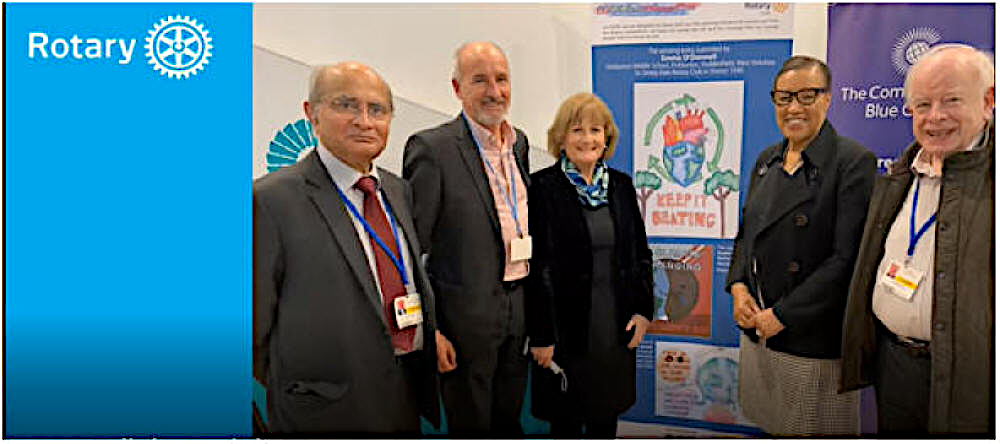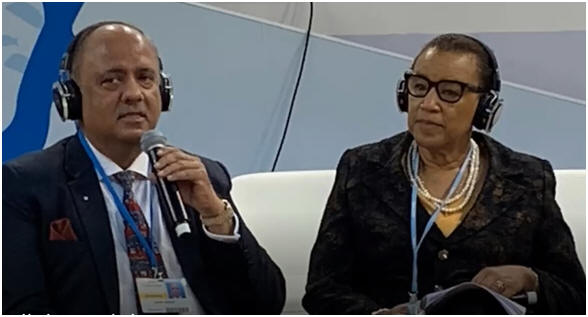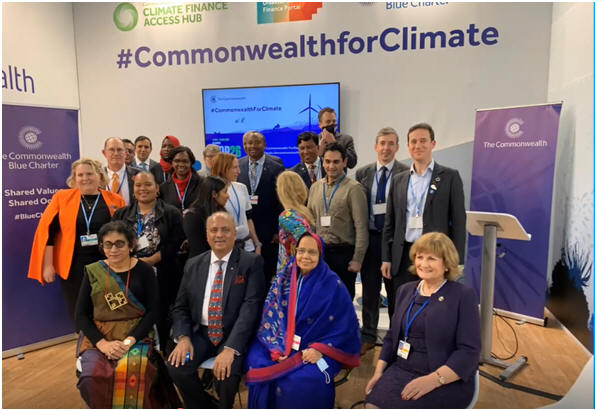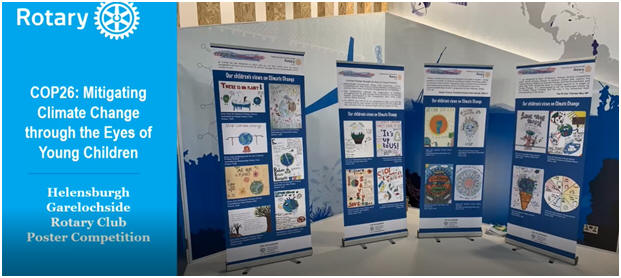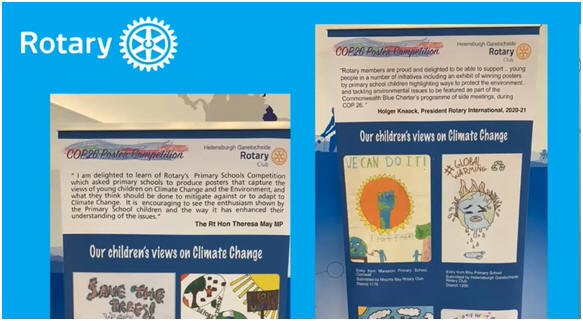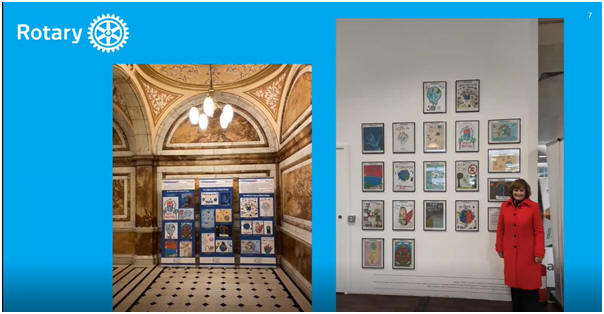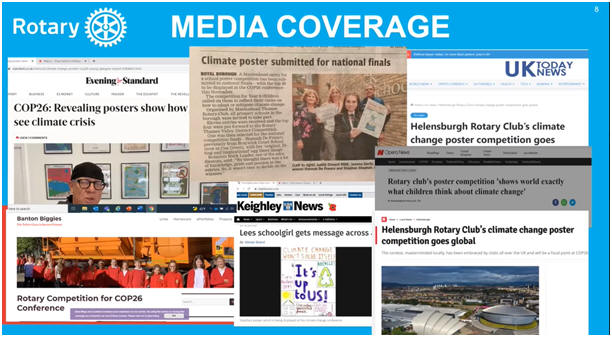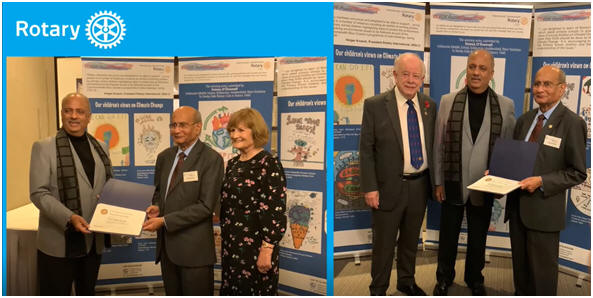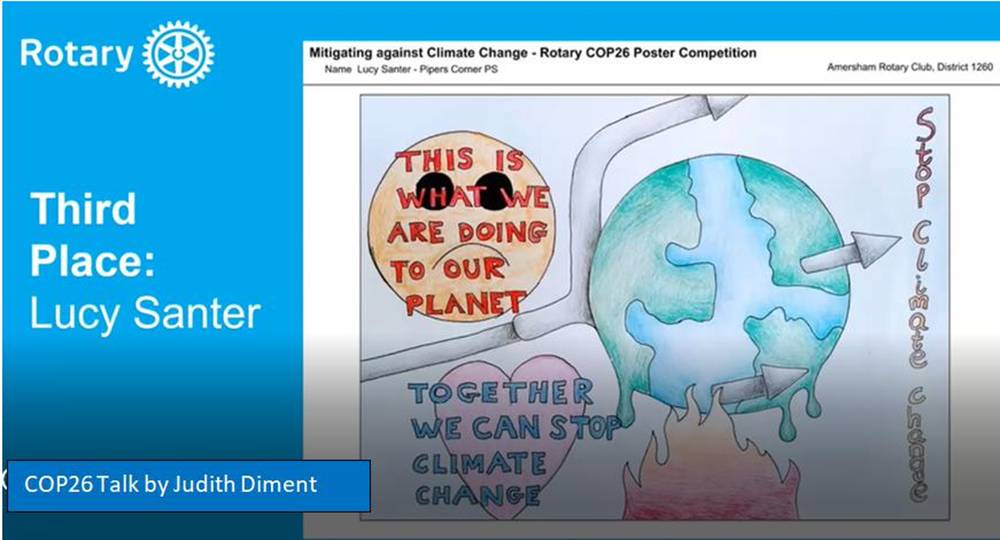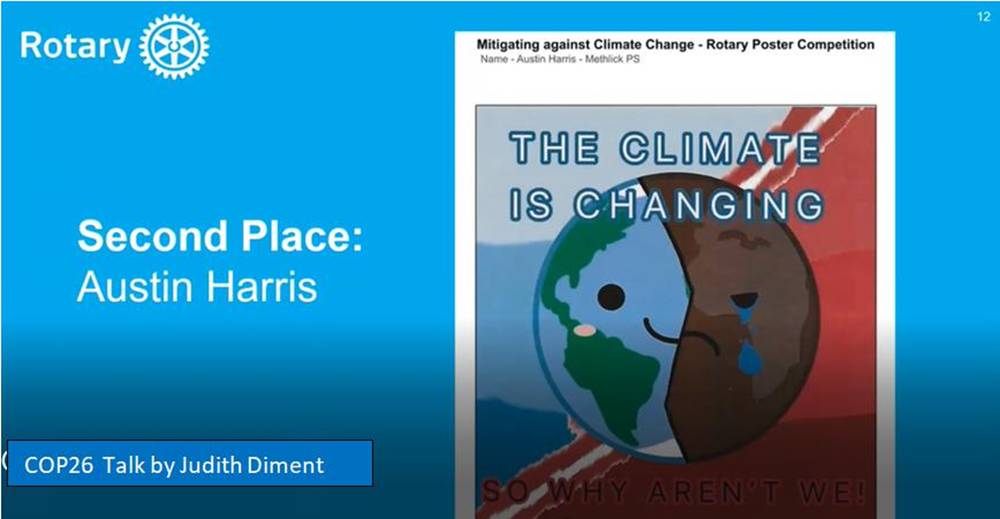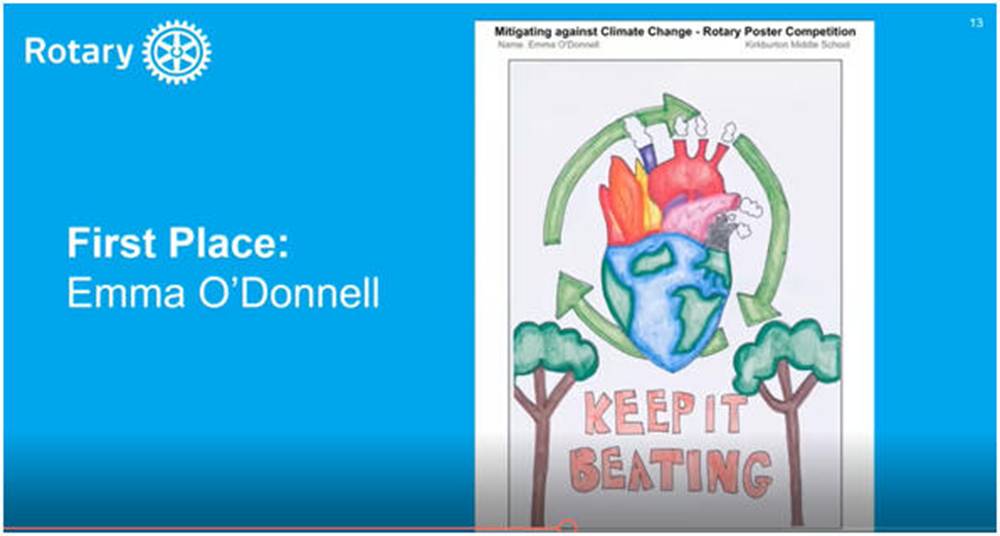|
What Rotary contributed to COP26, and how it was achieved
Transcript of a zoom briefing given to the Environmental
Sustainability Rotarian Action Group (ESRAG) by Ms Judith
Diment, MBE, Rotary delegation leader at COP26, Dean of the
Rotary International Representative Network to the UN and
international agencies.
QUOTE–
“COP26 was the first time that Rotary International had an
official delegation, which I was privileged to lead in my role
as Dean
of the Rotary Representatives to the UN and international
agencies.
Our representative network has thirty-one Rotary
representatives, and we represent Rotary at the UN and 21 other
agencies. I have quite a lot of experience, in fact over 10
years’ experience of representing Rotary at UN and other
international events, including our global Polio eradication
initiative, working with our partners WHO, UNICEF, US Centre for
Disease Control, and ‘The Bill and Melinda Gates Foundation’.
I have also been attending, for many years, Commonwealth Health
Ministers’ conferences, Commonwealth Heads of Government
meetings, World Health Summits and World Health Assemblies. I
have organised many advocacy events at both Houses of Parliament
in the
Our delegation comprised five Rotarians: myself, as leader of
the delegation, (centre) Douglas Wills, who is the alternate
representative for Rotary to the Commonwealth in
We were limited in the number of people we could have in the
delegation. Because of Covid, the UK Government, which was
hosting COP26, restricted the numbers. I think we applied to
have eight or ten delegates, but we were restricted to five – in
fact Tariq, although he is a Rotarian, did not come as part of
our Rotary delegation. He is a very eminent scientist and came
on behalf of one of his scientific associations. Rotary has had
UN observer status since the formation of the UN after World War
II. COP26 was hosted by the UK Government, and there were more
than 190 country delegations, with more than 1600 international
government organisations and national government organisations.
The conference was organised in two areas: a Blue Zone, and a
Green Zone. The Blue Zone held the Governments’ plenary sessions
and the delegates’ pavilions, also individual government and NGO
pavilions, and was only open to registered delegates. The Green
Zone, which was on the other side of the River Clyde, was open
to the public and included exhibitors from business and NGOs. We
did visit the Green Zone while we were there, but Rotary’s role
was very much participatory in the events taking place in the
delegations’ pavilions in the Blue Zone.
Partly because of Covid there was very little opportunity for
observers to engage in the main plenary discussions or influence
them. After 13 days of intense negotiations, COP26 concluded on
Saturday the 13thof November with every party at
COP26, representing almost 200 countries, agreeing the Glasgow
Climate Pact. This global agreement will accelerate action on
climate in this decade and finally completes the Paris Accord. A
record number of delegates gathered in
The aim of the UK COP26 Presidency was to keep alive the hope of
limiting the rise of global temperature to 1.5deg.C and the
Glasgow Climate Pact does just that. Combined with increased
ambition and action from the countries, 1.5deg. C remains in
sight, but it will only be achieved if every country delivers on
what it has pledged. The UK Government insisted that COP26 had
to be a face-to-face meeting, as it is impossible to conduct
detailed negotiations, often well into the night, on Zoom.
The key things coming out of COP26 were an agreement to reduce
Methane, [a fossil fuel commonly known as Liquid Natural Gas
(LNG). It is 25 times more lethal than CO2 to global
warming if released, as a gas directly into the atmosphere,
particularly arising from cattle farming and melting Arctic
permafrost]; a phasing out of coal–although they didn’t get as
much as they wanted, because India and China didn’t agree with
the original statement, but they have agreed to phase it out
more gradually; also stopping the destruction of forests: and
encouraging reforestation. So, there were some clear gains – and
I am absolutely convinced that we would never have achieved that
if we did it virtually, by Zoom - I know there is a lot of
criticism about thousands of people flying into
Because of the scale of the conference, and the small size of
the Rotary delegation, it was essential to have a clear focus,
based on existing relationships, in order to achieve anything
meaningful. So, my main focus was with the 54 countries of the
Commonwealth, building on engagement, over the last seven years,
with the Commonwealth Secretariat and High Commissions, and
maximising the opportunity of our Rotary President being from
India, the largest Commonwealth country.
So I had five priorities, based on a briefing meeting I had with
President Shekhar in February, and his brief to me was that he
would attend COP26 if I could organise a high-level discussion
with ministers. He wanted to work at ministerial level- he
didn’t want to come in and talk to junior assistants and NGOs -
he wanted to talk with ministers, as clearly, by talking to
ministers that’s
where you can make a difference, and change lives for the
better. So my first priority was developing a high level
engagement for the Rotary International President with
Government ministers and heads of NGOs.
And we achieved this by working at COP26 through the
Commonwealth Blue Charter team on the high-level Round Table
groups, attended by the Secretary General of the Commonwealth
and also seven environment ministers, ambassadors, and experts
from NGOs and academia.
And you might ask why did we choose mangroves? The reason for
this is that in 2018, at the Commonwealth Heads of Government
meeting, the Commonwealth launched the Commonwealth Blue
Charter, and, arising from this, are ten Commonwealth Action
Groups, on different aspects of the environment. One of these is
the Commonwealth Action Group on Mangroves, and when President
Barry Rassin was in
And, of course, the importance of mangroves is, first of all,
50% of mangroves have been lost in the last 30 years, and one of
the things I learned at COP26 is that mangroves have the highest
uptake of CO2 of any trees, so they are very, very
important from that point of view, but, of course, mangroves
also preserve the habitats of wildlife and fish, and many of the
local coastal communities are dependent on fishing in the
mangrove areas. But most importantly, having a strong mangrove
development along coastal areas helps to stop sea erosion when
you have hurricanes and typhoons.
So this is the reason for choosing mangroves, and we had some
seven ministers or their ambassadors at the High Level Round
Table on mangroves at COP26 hosted by President Shekhar Mehta
and the Secretary General of the Commonwealth, Baroness
Scotland.
Rotary President Mehta is seen here with Secretary General of
the Commonwealth Baroness Scotland
Before we got to COP26 I had a lot of discussions with the
minister in
The lady sitting on his left in the photo below is the deputy
minister from
The lady sitting to President Shekhar’s right is the Minister
from
A second aim was strengthening relations with delegates from the
UN and UN agencies, including the UN FCCC (UN Framework
Conventions on Climate Change), which, of course, organised
COP26 with the UK, also with the United Nations Environment
Programme, UN Habitat and key governments and other
international agencies and NGOs, and we achieved this by
attending many side events.
We got to COP26 by 8:00 o'clock most mornings and we were there
until about 6:00 o'clock most evenings. We went through the
programme and decided which - I mean there are hundreds of
meetings we obviously might have attended, and one had to be
selective - and I attended many meetings, including six meetings
where mangroves were being discussed in one way or another.
We attended many side events, but we also had one-to-one
meetings and some of the pavilion meetings we attended were
lengthy. For example,
I attended another Commonwealth meeting - another one on
mangrove restoration - with ministers from
Another aim I had was to create opportunities for action by
developing environmental service projects with partners, and as
I've mentioned already, we’ve achieved this through the round
table discussions on the commitment to start mangrove projects
in seven countries, but we also had one-to-one meetings, with
some gender-based organisations, so were looking to follow up
some gender - based projects, following several bilateral
meetings we had with President Shekhar.
We had meetings with the Global Alliance of Universities on
Climate and several women's organisations, and we are going to
be progressing how we can work with these organisations. Again,
with the Global Alliance of Universities on Climate, one of
their lead directors is a Rotarian, from the The fourth thing was to give young people a voice, and we achieved this with a wonderful project organised by the Helensburgh Garelochside Rotary Club, through their COP26 poster competition for Primary schools.
The twenty best short-listed posters were exhibited in five
locations in
We had quotes provided by former Prime Minister Rt Hon Theresa
May, and by Holger Knaack, the Rotary International President
2020 – 21, and one from the Lord Provost of Glasgow. So these
posters had a very high profile. All 20 short-listed posters
were displayed in the
A Rotary day at
We also hosted some receptions because we wanted to involve
Rotary in
This was the 3rd place poster by Lucy Santer who was from a
school in Buckinghamshire, Pipers Corner, submitted by the
Amersham Rotary Club.
Second place was Austin Harris from Aberdeenshire–I think the
concepts of these posters are just outstanding,
- And first place went to Emma O’Donnell from
I would sum up Rotary's attendance at COP26 as putting Rotary on
the global environment map. I received numerous comments from
delegates how pleased they were to see Rotary participating, and
many requests to work with Rotary going forward. The importance
of partnerships and involving civil society was mentioned in
most meetings I attended, and we can build on this for COP27 in
And, tomorrow I've got a meeting at the Commonwealth with Doug
Wills and Heidi Prislan where we are going to develop a strategy
for getting the projects in the several countries that were
announced by President Shekhar, so we are starting on that
process tomorrow. We look forward to working with Rotarians
right across the world, and we will work to help support these
projects in their countries and also with ESRAG, as working with
Rotary Action Groups is one of the remits of the Rotary
Representative Network.
So I'm happy to take questions. Thank you very much.”
A Q&A session was then introduced by Malcolm Rooney, ESRAG
Co-Chair:
“Okay, thank you very much. I will run through a few questions
which may not have been covered.”
Q Do you have a continuing role after COP26 and, if so, how does
this look like with ESRAG?
A - My appointment to the representative network is a Rotary
International appointment and it goes through 2022. I shall
certainly be working on this until next June, and I look forward
to working with ESRAG and other Rotarians on these projects.
Q What
did the RI President say about
A - Well I've not discussed that with President Shekhar
because he literally came in for two days, which was a massive
commitment for him, and we are very indebted to him for doing
that, but he had to fly back to a very big Rotary Institute
meeting in Tucson AZ, and the announcement about India not
committing didn't come out really until the Friday or Saturday
so, by then President Shekhar was back in the US, so I can't
comment on that.
Q My question is fairly straight forward. I take it the
delegation went to COP26 with many things they hoped to achieve.
What progress, added to meeting in various areas, are important
to Rotary worldwide? How much of that do you think you managed
to progress successfully?
A - Well I think that's what I've just outlined in my talk
actually. As I said, the environment is such a huge topic. The
conference had 30,000 delegates and there are meetings on all
aspects of the environment and climate change. It's impossible
for a small delegation to cover the whole spectrum of
environment and so, as I said in my talk, I focused on five
things. The main aim was President Shekhar’s high-level round
table discussion at ministerial level on mangroves, actually
homing in on something that is practical and do-able, where we
can get some action and some projects coming out of it.
Q The plans forCOP27. What and how can the delegation improve
next year?
A - As I mentioned at the end of my talk, I think the way
forward is to work with the UN agencies. We have 31
representatives in UN agencies, very talented, dedicated
individuals, many of whom have been ambassadors for their
country. It’s a very high level. Skilled people, and I think the
best way forward for us is to work with these agencies, such as
I mentioned, the UN Environment Programme in Nairobi, UN Habitat
in Nairobi, UNICEF, and UN FCCC, which was the organiser of
COP26, and incidentally, one of their directors, Dr Paul
Desanker, who came to our high-level discussion at COP26 hosted
by President Shekhar, is also a Rotarian, being President of
the Rotary Club of Bonn.
It was extraordinary how we have Rotarian’s popping up
everywhere. I'm used to this as wherever I go round the world,
you always find the Rotarians in key posts. So having Dr Paul
Desanker at UN FCCC could be a huge benefit to us going forward,
and he was extremely helpful throughout the process, getting the
delegation to COP26, and while we were there.
Q On a question about the necessity of Rotary delegates flying
around the globe to conferences; Judith, would you like to
expand on that?
A – Rotarians were working, meeting people right through every
day and we were not there having a ball. It was jolly, jolly
hard work and when I got back home each day, I was absolutely
exhausted. I would say the same thing is true about the Rotary
International Convention, although at the conventions there are
post-events, and you have a lot of fun. But it's not all about
that. Plenary sessions of the Rotary International Conventions
are serious. It’s a serious conference with world-class
speakers, all on really important topics, and you cannot do that
in the same way on Zoom.
Last year I participated in more than 250 Zoom meetings and,
yes, it's a way of connecting, and it was great being able to
connect with people all around the world very usefully, just
sitting at my desk at home, but it's not the same as meeting
face-to-face. There is absolutely no question in my mind, and I
pride myself on my networking skills, and I can tell you it's
extremely difficult to network on Zoom. But it's much easier
when you're face-to-face in a room with people, and you can
engage with them.
Q Will mangroves be a continued focus of concern for Rotary
after COP26?
A – Well, certainly going forward in the next 12 months, there’s
a brief from President Shekhar: we have to get mangrove projects
going in all these seven countries so, yes, we will certainly be
working on that. But that's not to say, you know, we're not
working on other things. That’s just one of many areas that
Rotary clubs will work on.
Q Thank you. How is Rotary planning to up the ante with the
environment for COP15? We did it with the campaign to end polio.
How can we get youth service clubs involved, and the findings
from COP26?
A – Well, my experience is this. Young people feel very strongly
about the environment, and for some it should be very easy to
engage with your Rotaract clubs, and I think Tariq and John
showed it with their poster competition, despite the pandemic,
despite schools and lockdowns, overstretched because of Covid.
They still had nearly 4,000 entries from school children wanting
to express themselves with regard to climate change. I think
that speaks for itself, and I think it beholds every Rotary Club
to get their Rotaract and Interact clubs involved with the
environment, and with all other aspects of Rotary action. For
clarification: COP15, is a Biodiversity
COP, a different series from the Climate COPs.
Q How and by whom was the Rotary delegation determined? To what
extent was ESRAG GB&I and the Environmental Sustainability group
represented at cop 26?
A - Karen Kendrick-Hands was the representative for ESRAG. As I
said, we only had 5 delegates, although I think eight were
submitted and so four of the ESRAG members were not able to
come because of the Covid restrictions. The selection was done
through Rotary International, and we've been having Zoom
meetings with ESRAG, both the International ESRAG and ESRAG in
Q You haven't touched on nuclear energy. Was nuclear energy a
subject of debate and controversy? Or is there a consensus that
nuclear energy is a necessary means to reach the COP26
reductions targets?
A - I think I did see one or two meetings in the programme, but
I don't know what the outcome of those were with COP26.
Q Rotary action groups have dedicated people with technical
expertise. How can you with your role strengthen our
relationship with UN agencies? That would be fantastic and
incredibly helpful for progress, to work more with UN agencies.
A - As the Rotary representative network, part of our remit is
to work with Rotary action groups. We are doing that quite
successfully with several action groups and we would like to
work well with ESRAG.
Q What realistic impact will Rotary be able to make during 2022?
Are we being taken seriously?
A – Yes. I think we'll be able to make an impact. If we can get
the mangrove projects off the ground, and we're also looking at
a
Paraphrasing President Shekhar, he said something to the effect
that “Climate Change has been seen as a political matter. Now it
is an “existential question”, and to my mind the future of
humanity will be determined by political decision-making.
Q How does Rotary engage with politicians?
A – Well, I think through the work that we do. We need to do
advocacy with politicians - to highlight the importance of
mitigating climate trends. And doing a lot of work with the
Commonwealth. Many of the Commonwealth countries, both in the
That is massive. You know we have a terrible migrant problem in
the
Q Were population issues part of the discussions?
A - Not that I was aware of.
Q Is there an opportunity for clubs and districts to get on
board with this mangrove project, and when is that possible? And
in what way would that be helpful?
A - Absolutely! As I said, tomorrow I've got a meeting with the
Commonwealth Secretariat because in the countries that President
Shekhar listed, (several are Commonwealth countries), the
feeling is that we wanted some sort of template, so that we are
all working in the same way. I think there could be scope if
some of the pilot studies
that we are trying to get off the ground happen, there may be
scope for quite a big global demand. You know, joining up
countries, say, in
Q What are the proper channels to follow when Rotarians wish to
contact UN organisations? Is there a protocol for contacting
individual UN organisations?
A - I would suggest, in the first instance, that they come
through the Rotary representative network in the UN, because we
have representatives at all the key agencies, and they could be
the best conduits. If you want to contact or work with them, do
it through the Rotary representatives to the UN.
The thing that impressed me was a comment by John Kerry, US
Presidential Envoy on Climate and Energy, leader of the ENDS
For a full copy of this article as a
Word document, contact Francis Phillips at:
fephillips27@msn.com “
|
